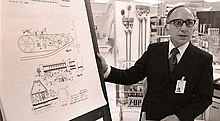Norman Joseph Woodland
| Norman Joseph Woodland | |
|---|---|
 |
|
| Born |
September 6, 1921 Atlantic City, New Jersey |
| Died | December 9, 2012 (aged 91) Edgewater, New Jersey |
| Alma mater | Drexel University |
| Known for | Co-inventor of the barcode |
Norman Joseph Woodland, also known as N. Joseph Woodland and N. J. Woodland (September 6, 1921 – December 9, 2012) was an American inventor, best known as one of the inventors of the barcode, for which he received a patent in October 1952. Later, employed by IBM, he developed the format which became the ubiquitous Universal Product Code (UPC) of product labeling and check-out stands.
Woodland was born in Atlantic City, New Jersey on September 6, 1921 to Jewish parents, the elder of two boys.
After graduating from Atlantic City High School, Woodland did military service in World War II as a technical assistant with the Manhattan Project in Oak Ridge, Tennessee. Woodland went on to earn his Bachelor of Science in Mechanical Engineering (BSME) from Drexel University (then called Drexel Institute of Technology) in 1947. From 1948-1949, he worked as a lecturer in mechanical engineering at Drexel.
In 1948, Bernard Silver, a fellow Drexel Institute graduate student with Woodland, overheard a supermarket executive asking the dean of engineering if the Institute could determine how to capture product information automatically at checkout. The dean turned down the request, but Silver was interested enough to mention the problem to Woodland. After working on some preliminary ideas, Woodland was persuaded that they could create a viable product.
Woodland took some stock market earnings, quit his teaching job and moved to his grandfather's Florida apartment. While at the beach, Woodland again considered the problem, recalling, from his Boy Scout training, how Morse code dots and dashes are used to send information electronically. He drew dots and dashes in the sand similar to the shapes used in Morse code. After pulling them downward with his fingers, producing thin lines resulting from the dots and thick lines from the dashes, he came up with the concept of a two-dimensional, linear Morse code, and after sharing it with Silver and adapting optical sound film technology, they applied for a patent on October 20, 1949, receiving U.S. Patent 2,612,994 Classifying Apparatus and Method on October 7, 1952, covering both linear barcode and circular bulls-eye printing designs.
...
Wikipedia
